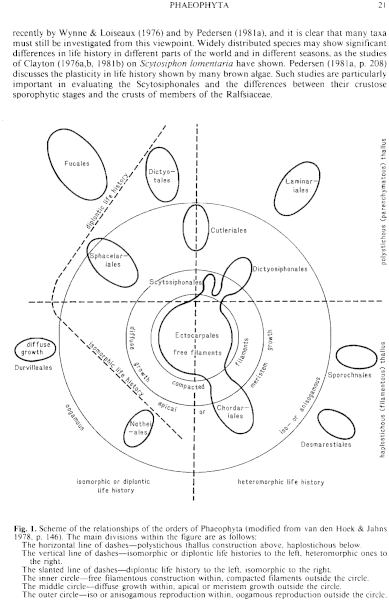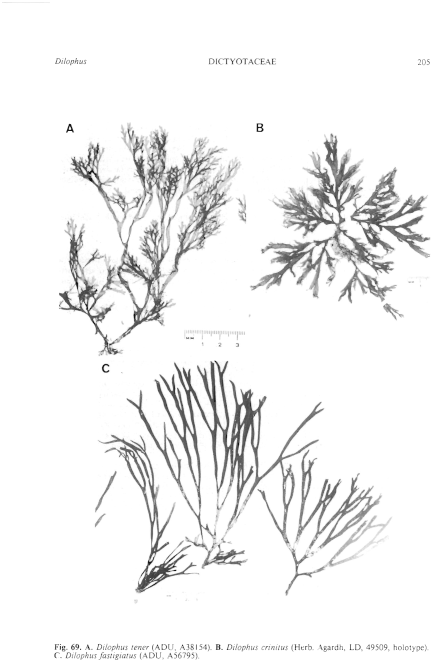|
|
|
|
|
|||||||||||
|
Electronic Flora of South Australia Species Fact Sheet
Phylum Phaeophyta – Order Dictyotales – Family Dictyotaceae – Tribe Dictyoteae
Selected citations: Womersley 1967: 213.
Thallus (Fig. 69A) light to medium brown, delicate, 8–20 cm long, moderately densely branched with dichotomous main branches and younger laterals becoming alternately arranged (Figs 68H, 69A), branching at intervals of 1–3 cm below, decreasing to 2–4 mm above; lower branches 2–3 mm broad, upper laterals (0.5–) 1–2 mm broad, tapering to a pointed apex with a protruding apical cell, axils mostly rounded, proliferations few to absent. Holdfast rhizoidal; epilithic. Cortical cells 14–25 (–30) µm across, L/B 1–3. Medulla (Fig. 68I,J) 1–2 cells thick centrally throughout most of thallus (occasionally 4–5 cells thick close to the base-Fig. 68K), 2–3 (–4) cells thick near the margins; thickness centrally 120–200 µm, marginally 250–320 µm. Hair tufts scattered, hairs 10–16 µ in diameter.
Reproduction: Tetrasporangia (Fig. 681) 120–200 µm in diameter, scattered, sparse. Oogonial sori scattered, circular to ovate, 200–300 µm long and 160–220 µm across. Antheridial sori scattered, ovate, 300–500 (–600) µm long and 200–300 µm across.
Type from Port Phillip Heads, Vic. (Wilson, Jan. 1882); in Herb. Agardh, LD, 49650.
Distribution: Known from the type locality (specimens in MEL) and from Israelite Bay, W. Aust., drift (Willis, 27.xi.1950: ADU, A15854); Pearson I., S. Aust., 13–23 m deep (Shepherd, 8.i.1969; ADU, A34095); Investigator Strait, S. Aust., 41 m deep, 35°24'S, 137°07'E (Watson, 14.i.1971; ADU, A38154); and Dubious Rock, West I., S. Aust., 22 m deep (Shepherd, 3.i.1966; ADU, A30323).
Taxonomic notes: Dilophus tener is one of the most delicate species of Dilophus, characterised by the alternately placed upper laterals, in contrast to D. angustus which is largely dichotomous throughout. D. tener appears to be a deep water species on open coasts.
References:
AGARDH, J.G. (1894a). Analecta Algologica. Cont. I. Acta Univ. lund. 29, 1–144, Plates 1, 2.
WOMERSLEY, H.B.S. (1967). A critical survey of the marine algae of southern Australia. II. Phaeophyta. Aust. J. Bot. 15, 189–270.
The Marine Benthic Flora of Southern Australia Part II complete list of references.
Publication:
Womersley, H.B.S. (14 December, 1987)
The Marine Benthic Flora of Southern Australia
Part II
©Board of the Botanic Gardens and State Herbarium, Government of South Australia
Illustrations in Womersley Part II, 1997: FIGS 681–1-K, 69A.

Figure 1 enlarge
Fig. 1. Scheme of the relationships of the orders of Phaeophyta (modified from van den Hoek & Jahns 1978, p. 146). The main divisions within the figure are as follows:
The horizontal line of dashes-polystichous thallus construction above, haplostichous below.
The vertical line of dashes-isomorphic or diplontic life histories to the left, heteromorphic ones to the right.
The slanted line of dashes-diplontic life history to the left, isomorphic to the right.
The inner circle-free filamentous construction within, compacted filaments outside the circle.
The middle circle-diffuse growth within, apical or meristem growth outside the circle.
The outer circle-iso or anisogamous reproduction within, oogamous reproduction outside the circle.

Figure 69 enlarge
Fig. 69. A. Dilophus tener (ADU, A38154). B. Dilophus crinitus (Herb. Agardh, LD, 49509, holotype). C. Dilophus fastigiatus (ADU, A56795).

|
Email Contact: State Herbarium of South Australia |

|